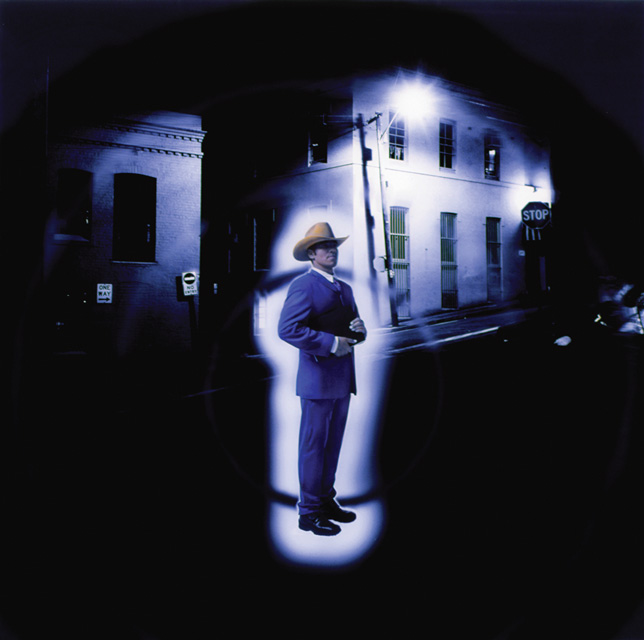


Brook Andrew's black preacher in The proselytizer (2000) is a Rückenfiguren of the inner-city. The German romantic artist, Caspar David Friedrich, used the Rückenfiguren—the sole figure gazing over a daunting landscape—in such famous works as Wanderer above the mists (1818). The view in Friedrich's painting is obscured in cloud and mist; an unknown and unseen landscape. In Andrew's work, the background is obscured in darkness, the street lighting casting theatrical, threatening shadows.
In Friedrich's distinctly European work the sole figure takes on a heroic role. Andrew's figure is no less heroic. Indeed, Andrew's figure, black, clutching a 'Blak Bible' and standing illuminated in a hostile environment surrounded by signs stating Stop, No Entry and One Way—resonates with an obstinate, if potentially misguided, courage.
The proselytizer—like most of Andrew's œuvre—is a multi-layered work, both conceptually and technically. Andrew's images simultaneously tackle his Aboriginal heritage (he is of the Wiradjuri nation) and his position as a sophisticated western artist working in new media. The proselytizer straddles this divide; his preacher wears an Akubra hat but is dressed in a Saba suit—the outback meets the urbane. The cowboy hat may refer to the days of the missions when many Indigenous men became stockmen and mastered the feral horses of the region, but the smooth suit clearly states that those days are changing.
This image is also multi-layered in terms of its technical creation. Like a number of younger Australian artists, Andrew has taken on such media as neon, digital imaging, video and text. According to Andrew:
The obligations most individuals have today with multiple global identity and cultural politics resembles, somewhat, a locust on heat. Focusing on the intentions of the mass, electronic and published media, I aim to interrogate contemporary global culture, teasing from populism to spew forth ironic takes on 'globalism', mixing and representing cultural identities from Australia, neighbouring countries of Asia and the ‘Americas’. Our obsession/anxiety with artificial and popular constructs of Australian Indigenous and other cultures, celebrity personality, war, supremacy, revolution and spiritual fulfilment are manifest through mass media/cultural activity, lighting up our lives with popular, mostly singular illusions and extrusions of something that is not always 'us'/'me'.1
In this regard The proselytizer becomes a universal figure: the individual rather than a figure symbolic to any singular cause. This ambiguous position points to Andrew's passionate attempt to break down the mystification and stereotyping of figurative imagery.
There may also be humour in this work, but it is an unsettling, perhaps even bitter humour. Andrew is all too aware of the history of Aboriginal people as subject for a voyeuristic, ethnographic, even obscene history of photography in Australia from the nineteenth-century onwards. As subject, the Aboriginal was cast as the last primitive, a dying race, a people as odd to the European eye as the platypus. The proselytizer turns the tide on that history, but simultaneously the work is not caught in that one singular reading.
Andrew subverts clichés about received wisdom, about how advertising works, the notion of the Aboriginal as culturally removed from western society. The preacher's Blak Book is intended to represent the collected knowledge, wisdom and culture of Australia's Indigenous people. It is a symbol—an impossible tome given that much of this culture is unwritten and secret, and that there are more than 250 nations and a multitude of languages. Many of the belief systems overlap and conflict. Perhaps the Blak Book is wishful thinking, but it is more likely that, as a potent symbol, it makes a statement for Australia’s Indigenous people as potentially profound as the Bible for a Christian or the Koran for a Muslim. Andrew’s proselytiser is a powerful figure, proud in the dark streets of urban prejudice.
- Ashley Crawford
Brook Andrew is represented in Australia by Tolarno Galleries, Melbourne and Roslyn Oxley9 Gallery, Sydney.